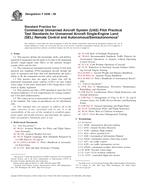We need your consent to use the individual data so that you can see information about your interests, among other things. Click "OK" to give your consent.
ASTM F2636-08
Standard Practice for Commercial Unmanned Aircraft System (UAS) Pilot Practical Test Standards for Unmanned Aircraft Single-Engine Land (SEL) Remote Control and Autonomous/Semiautonomous (Withdrawn 2014)
STANDARD published on 15.3.2008
The information about the standard:
Designation standards: ASTM F2636-08
Note: WITHDRAWN
Publication date standards: 15.3.2008
SKU: NS-54283
The number of pages: 13
Approximate weight : 39 g (0.09 lbs)
Country: American technical standard
Category: Technical standards ASTM
Annotation of standard text ASTM F2636-08 :
Keywords:
commercial UAS pilot, single-engine land, UAV, unmanned aircraft, unmanned aircraft pilot, unmanned aircraft practical test standard, ICS Number Code 49.020 (Aircraft and space vehicles in general)
Additional information
| Significance and Use | ||||
|
Unmanned aircraft present unique challenges for applicants and examiners. Unlike manned aircraft, in which, regardless of the size and complexity of the aircraft, there are still basic similarities in concepts and operations, unmanned aircraft are varied in both flight capability and pilot interaction. Many aspects of unmanned aircraft operations are automated, and the pilots may not have the same information available to them (that is, pitch and bank) that pilots flying manned aircraft have available to them. This will create a situation in which some unmanned aircraft systems (UAS) will not be capable of meeting all the requirements of this practice or will not require the same skill sets that manned aircraft require. The examiner will have to decide which tasks the applicant's UAS will be capable of completing and test those tasks. As required, the examiner will note any limitations as a result of the UAS being incapable of performing a task on the applicant's certificate per 14 CFR 61.45(b)(2). If the applicant desires to have a certificate with no restrictions or limitations, he/she will need to use a UAS that is capable of completing all the tasks in this practice. Information considered directive in nature is described in this practice by the use of “shall” and “must” indicating the actions are mandatory. Guidance information is described in terms such as “should” and “may” indicating the actions are desirable or permissive but not mandatory. A list of acronyms is in Section 3. This practice includes the areas of operation and tasks that will demonstrate the pilot's ability to fly the unmanned aircraft safely and proficiently. |
||||
| 1. Scope | ||||
|
1.1 This practice defines the knowledge, skills, and abilities required of unmanned aircraft pilots to be able to fly unmanned aircraft—single-engine land (SEL) in the national airspace system safely and for hire. 1.2 The commercial unmanned aircraft systems (UAS) pilot practical test standards (PTS)-unmanned aircraft include the areas of operation and tasks that will demonstrate the pilot's ability to fly the unmanned aircraft safely and proficiently. 1.3 This practice does not apply to pilots who will fly mini/small unmanned aerial vehicles (UAVs) for hire within visual range of the pilot, mini/small UAVs being those UAVs listed as lightly regulated. 1.4 This practice provides a PTS intended to meet the Civil Aviation Authority’s (CAA) requirements for issuing commercial UAS pilot authorizations. 1.5 The values given in inch-pound units are to be regarded as the standard. The values in parentheses are for information only. 1.6 This standard does not purport to address all of the safety concerns, if any, associated with its use. It is the responsibility of the user of this standard to establish appropriate safety and health practices and determine the applicability of regulatory limitations prior to use. |
||||
| 2. Referenced Documents | ||||
|
We recommend:
Technical standards updating
Do you want to make sure you use only the valid technical standards?
We can offer you a solution which will provide you a monthly overview concerning the updating of standards which you use.
Would you like to know more? Look at this page.




 Cookies
Cookies
